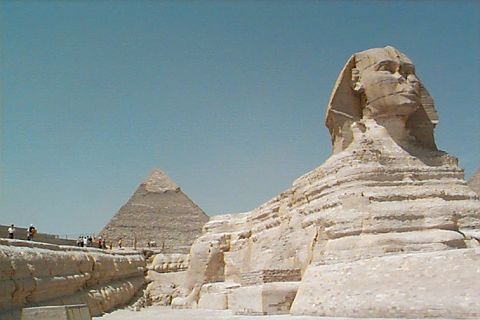of king Khafre - builder of the second largest pyramid on the Giza plateau. Its head probably depicts Khafre and the body is
that of a recumbent lion.The Sphinx is about 73.5 metres in length. It was originally sculptured from a limestone outcrop and, for most of its history, the
Sphinx has been at least partly covered in sand. The first recorded clearing took place in the 18th Dynasty when a prince, who
later became the pharaoh Thutmose IV, ordered that the sand be removed. This happened after he supposedly had a dream in
which he was told that he would become pharaoh if he cleared the Sphinx.Unfortunately, in recent centuries, the Sphinx has suffered greatly from the influence of man and exposure to the environment.
Numerous attempts have been made to restore the figure and additional modern limestone blocks have been added around the
base.In front of the Sphinx is its temple, while adjacent to it is the better preserved Valley Temple of Khafre. A causeway, seen
behind the Sphinx, connected Khafre's Mortuary Temple next to his pyramid with the Valley Temple.
At night, Sound & Light shows are performed at Giza and the audience is seated in an area located to the left of this view.At night a Sound And Light show is performed relating the history of Egypt and the Sphinx. The show is viewed from an area
to the east of the Sphinx and pyramids and you should check the language schedule.

BACK